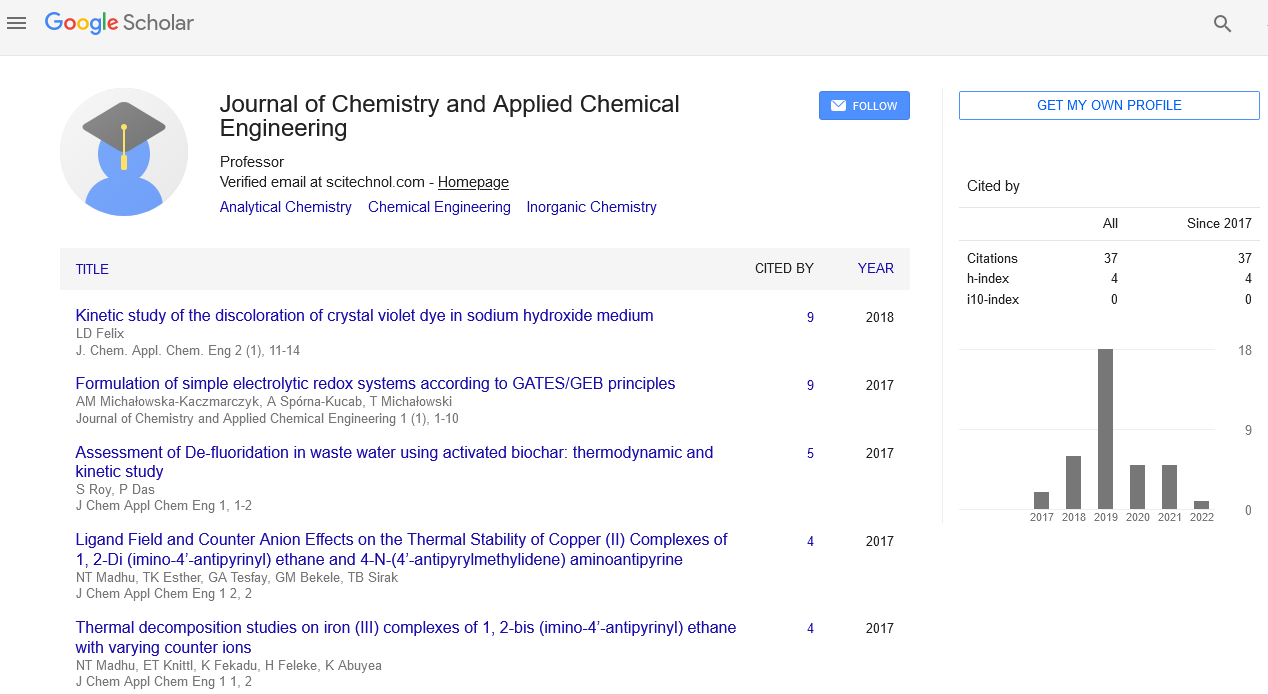The morphological, structural, optical and antibacterial characteristics of Cr2O3 nanoparticles: A comprehensive study
Naif Mohammed Al-Hada and Halimah Mohamed Kamari
University Putra Malaysia, Malaysia
: J Chem Appl Chem Eng
Abstract
Calcination via thermal treatment using a precursor material is employed in the generation of Cr2O3 nanoparticles. Precursor materials included chromium nitrate in addition to a capping agent of polyvinylpyrrolidone. A range of analytical techniques: X-ray diffraction (XRD); energy dispersive X-ray (EDX); transmission electron microscopy (TEM); and Fourier Transform Infrared Spectroscopy (FTIR) were used to characterise the samples generated. The observation that the Cr2O3 nanoparticles results exhibited hexagonal crystalline structures was demonstrated by XRD analysis. The Cr and O in the Cr2O3 nanoparticle samples was confirmed as original materials using energy-dispersive X-ray spectroscopy and Fourier-transform infrared spectroscopy phase analysis. TEM results demonstrated that the different of calcination temperature from 500 to 800 oC resulted in an increase average nanoparticle size from 4 nm to 16 nm. X-ray photoelectron spectroscopy (XPS) analyses were used to investigate surface composition and valence state of the final nanoparticle product. Assessment of the optical energy gap using the Kubelka–Munk equation was achieved by utilization of diffuse UV–visible reflectance spectra, revealing that the energy band gap reduced with increasing calcination temperature: from 3.12 to 3.01 eV. Furthermore, increasing particle size was also found to be associated with increased photoluminescence as demonstrated by photoluminescence (PL) spectra. Lastly, antibacterial activity of the chromium oxide nanoparticle was assessed in-vitro using Escherichia coli ATCC 25922 Gram (-ev) and Bacillus Subtilis UPMC 1175 Gram (+ev).
Biography
Naif M. Al-Hada received the BSc degree in physics in 2003 and the MSc in Applied Radiation and PhD degrees in physics (Nanoscience) from the Faculty of Science, University Putra Malaysia (UPM), Malaysia, in 2011 and 2015 respectively. He is an Assistant Professor of Physics. He is currently a Postdoctoral Researcher at Department of Physics, Faculty of Science, UPM. His research interests include nanoparticles synthesis & applications (especially for renewable energy and biomedicine), metallic oxides nanostructures and its antibacterial activity, binary oxide nanostructures for solar cell and sensor applications polymer composites/nanocomposites, conducting polymer nanocomposites and semiconductor nanotechnology applied radiation. He has published more than 30 papers in reputed journals and has been serving as an editorial board member of repute.
E-mail: naifalhada@yahoo.com
 Spanish
Spanish  Chinese
Chinese  Russian
Russian  German
German  French
French  Japanese
Japanese  Portuguese
Portuguese  Hindi
Hindi 